Synthesis and Characterization of a Water-Soluble Nanomaterial via Deep Nitration of Light Fullerene C60
Abstract
1. Introduction
- Electrophilic H–NO2 substitution (infeasible for hydrogen-free C60)
- H-substitution via N2O5 (also impossible for C60)
- Addition of HNO3 across C═C to give nitro-alcohols
- Addition of pure HNO3 to yield nitro-ethers
- Radical addition of NO2•, N2O3, or N2O5 affording mono- or di-nitroadducts, nitro-alcohols, nitro-esters, or their mixtures [18]
- Multi-step sequences combining these elementary reactions
- (A)
- Let us first focus on the article [28], which most fully corresponds to the thematics of our article, i.e., the direct nitration of fullerene C60. Nitration of fullerene molecules has been carried out under different conditions and nitration reagents, including a mixture of conc. HNO3 and sodium nitrite, dinitrogen tetroxide, fuming nitric acid, and a mixture of aqueous sodium nitrite, FeSO4, and H2SO4 in the presence of air. Hexaanilino [60]fullerenes (), as the predominant nitration product, have been described [28]. In an aqueous alkaline solution, rapid and complete hydrolysis of poly-nitrofullerenes was observed to produce fullerenol molecules containing at least 16 hydroxy- groups per C60 core [28]. The latter, in our opinion, indirectly indicates a deeper course of fullerene nitration up to 16 nitro groups, at least for a part of the mixture of products obtained in this work. The mixed composition of poly-nitroadducts during nitration is also indirectly confirmed by the results of HPLC studies, where the yield of a mixture of products from the column is characterized by a mixture of 4–7 chromatographic peaks [28] with a mixture output time of several minutes. At the same time, with an increase in the synthesis time from 24 h to 144 h of HPLC, the picture is significantly simplified. From the latter, it can be assumed that either longer synthesis times, more intensive mixing, or a higher temperature could have been used to complete the nitration process.
- (B)
- Article [11] is also directly devoted to the direct fullerene nitration. The nitration of fullerene molecules has been carried out under different conditions and nitration reagents (very close to [28]), including a mixture of conc. HNO3 and sodium nitrite (7), dinitrogen tetroxide, fuming nitric acid, and a mixture of aqueous sodium nitrite, FeSO4, and H2SO4 in the presence of air. However, polynitrofullerenes react slowly with H2O to yield partially hydroxylated products of poly(hydroxynitro)fullerenes. In the presence of an aqueous alkaline solution, rapid and complete hydrolysis of poly-nitrofullerenes was observed to produce fullerenol molecules containing at least 16 hydroxy groups per C60 core. The result of nitration in this work is also very close to the article [28], the formation of two main poly-nitroadducts, tetra- and hexa-derivatives, was found. However, the authors of the review [11] come to more cautious conclusions, noting that in some studies reported, C60 was nitrated by the multiple addition of NO2 and the product isomerized partly to the nitrito form with subsequent hydrolysis by atmospheric moisture to yield nitrofullerols consisting of 6–8 nitro and 7–12 hydroxy groups per C60.
- (C)
- Authors [28] summarize the recent progress of functionalized fullerene materials (i.e., fullerene derivatives) that have been applied in PSCs, focusing on chemical functionalization strategies. Despite the completeness and undoubted value of the presented review, the last one is generalized and non-specific and has no direct relation to the topic of our article related to the direct nitration of fullerene C60. The goal of the authors [28] was to propose an outlook on the future development of fullerene derivatives in realizing high-performance PSC devices.
- (D)
- Article [30] is devoted to the consideration of the major types of multi-functionalized fullerenes through selected examples with a link to the structural assignments. At the same time, the structural features of fullerene derivatives are the main subject of this review. At the same time, this aspect of the review is not the main and essential determinant in our work.
2. Results
2.1. Synthesis of the Polynitro-Hydroxylated Adduct C60(NO2)18(OH)2
2.2. Structural Characterization
Elemental and Spectroscopic Evidence
- ν(O–H): 3449
- ν(NO2): 1647, 1348, 1560
- δ(NO2) (“scissoring”): 733, 638, 617
- ν(C–O): 1790, 1647, 1152, 1063
- ν(C–N): 1113 (strong), 833
- ν(C–O–N): 2982
- Fullerene core vibrations: 997, 733, 484, 457 [9]
- Column—Agilent Zorbax SB-C18;
- Eluent—CH3CN/H2O (1:20, v/v);
- Detection—spectrophotometric monitoring at λ = 330 nm.
- 60–100 °C: decomposition of crystallohydrates due to external dehydration;
- 170–250 °C: breakdown of hydroxyl groups, corresponding to internal dehydration;
- 400–650 °C: gradual thermal degradation of relatively stable nitro groups;
- 680–740 °C: active decomposition of residual nitro substituents;
- 800 °C and above: explosive destruction of remaining nitro groups and oxidative combustion of the fullerene core.
- Monomeric molecules of C60(NO2)18(OH)2, with an estimated hydrodynamic diameter of δ ≈ 2 nm, are dominant at concentrations C ≤ 0.00195 g/dm3.
- In the range of 0.00195–0.50 g/dm3, first-order associates form, with sizes around δ ≈ 50 ± 10 nm.
- Between 0.0624 and 2.0 g/dm3, second-order associates (nanocolloidal particles) are observed, with sizes approximately δ ≈ 170 ± 50 nm.
- At concentrations C ≥ 1.0 g/dm3, third-order associates (microcolloids) with sizes up to δ ≈ 5 ± 0.6 µm coexist with second-order aggregates.
- At the cathode:
- At the anode:
- Overall cell reaction:
- Cathodic half-reaction:
- Anodic half-reaction:
- Overall cell reaction:
3. Discussion
4. Materials and Methods
5. Conclusions
Supplementary Materials
Author Contributions
Funding
Institutional Review Board Statement
Informed Consent Statement
Data Availability Statement
Conflicts of Interest
Abbreviations
| IR | Infrared Spectroscopy |
| UV-Vis | Ultraviolet–Visible Spectroscopy |
| NMR | Nuclear Magnetic Resonance |
| HPLC | High-Performance Liquid Chromatography |
| TG-DTA | Thermogravimetric and Differential Thermal Analysis |
| XRD | X-ray Diffraction |
| SEM-4 | Sechenov Extended Model (four-parameter) |
| VD-AS | Virial Decomposition Asymmetric Model |
| Dissociation Constant (Acid-Base) | |
| ζ-Potential | Zeta Potential (Electrokinetic Potential) |
| C60 | Fullerene C60 |
| NO2 | Nitro Group |
| OH | Hydroxyl Group |
| NaCl | Sodium Chloride |
| HNO3 | Nitric Acid |
| H2SO4 | Sulfuric Acid |
| H2O2 | Hydrogen Peroxide |
References
- Ganjoo, R.; Assad, H.; Sharma, P.K.; Kaya, S.; Kumar, A. Fullerenes as Anticorrosive Coating Materials. In Smart Anticorrosive Materials; Elsevier: Amsterdam, The Netherlands, 2023; pp. 91–107. [Google Scholar] [CrossRef]
- Hirsch, A. Fullerene Derivatives for Medical Applications. In Proceedings of the AIP Conference Proceedings, Salt Lake City, UT, USA, 10–11 August 2005. [Google Scholar] [CrossRef]
- Chiang, L.Y.; Lu, F.-J.; Lin, J.-T. Medical Applications of Water-Soluble Polyhydroxylated Fullerene Derivatives. MRS Proc. 1994, 359, 327. [Google Scholar] [CrossRef]
- Mumyatov, A.V.; Troshin, P.A. A Review on Fullerene Derivatives with Reduced Electron Affinity as Acceptor Materials for Organic Solar Cells. Energies 2023, 16, 1924. [Google Scholar] [CrossRef]
- Bakry, R.; Vallant, R.M.; Najam-Ul-Haq, M.; Rainer, M.; Szabo, Z.; Huck, C.W.; Bonn, G.K. Medicinal Applications of Fullerenes. PubMed 2007, 2, 639–649. [Google Scholar]
- Moztarzadeh, O.; Jamshidi, M.; Taherpour, A.A.; Babuska, V. Molecular Modelling of Fullerene C60 Functionalized by Nitric Oxide for Use in Biological Environment. Sci. Rep. 2024, 14, 2565. [Google Scholar] [CrossRef] [PubMed]
- Chien, C.-T.; Lee, P.-H.; Chen, C.-F.; Ma, M.-C.; Lai, M.-K.; Hsu, S.-M. De Novo Demonstration and Co-Localization of Free-Radical Production and Apoptosis Formation in Rat Kidney Subjected to Ischemia/Reperfusion. J. Am. Soc. Nephrol. 2001, 12, 973–982. [Google Scholar] [CrossRef]
- Kausar, A. Potential of Polymer/Fullerene Nanocomposites for Anticorrosion Applications in the Biomedical Field. J. Compos. Sci. 2022, 6, 394. [Google Scholar] [CrossRef]
- Mashino, T.; Okuda, K.; Hirota, T.; Hirobe, M.; Nagano, T.; Mochizuki, M. Inhibition of E. Coli Growth by Fullerene Derivatives and Inhibition Mechanism. Bioorganic Med. Chem. Lett. 1999, 9, 2959–2962. [Google Scholar] [CrossRef]
- Bhakta, P.; Barthunia, B. Fullerene and Its Applications: A Review. J. Indian Acad. Oral Med. Radiol. 2020, 32, 159. [Google Scholar] [CrossRef]
- Yang, B.; Chen, Y.; Shi, J. Reactive Oxygen Species (ROS)-Based Nanomedicine. Chem. Rev. 2019, 119, 4881–4985. [Google Scholar] [CrossRef]
- Ding, R.G.; Lu, G.Q.; Yan, Z.F.; Wilson, M.A. Recent Advances in the Preparation and Utilization of Carbon Nanotubes for Hydrogen Storage. J. Nanosci. Nanotechnol. 2001, 1, 7–29. [Google Scholar] [CrossRef]
- Acquah, S.F.A.; Penkova, A.V.; Markelov, D.A.; Semisalova, A.S.; Leonhardt, B.E.; Magi, J.M. Review—The Beautiful Molecule: 30 Years of C60and Its Derivatives. ECS J. Solid State Sci. Technol. 2017, 6, M3155–M3162. [Google Scholar] [CrossRef]
- Biazar, E.; Majdi, N.; Zafari, M.; Avar, M.; Aminifard, S.; Zaeifi, D.; Ai, N.; Jafarpour, N.; Montazeri, N.; Gh, N. Nanotoxicology and Nanoparticle Safety in Biomedical Designs. Int. J. Nanomed. 2011, 6, 1117–1127. [Google Scholar] [CrossRef] [PubMed]
- Lashneva, V.V.; Tkachenko, Y.G.; Dubok, V.A.; Schur, D.V.; Sychev, V.V.; Matveeva, L.A. Prospects of Usage of Materials with Fullerene Coatings for Endoprosthesis of Joints. In Nanostructured Materials and Coatings for Biomedical and Sensor Applications; Springer: Berlin/Heidelberg, Germany, 2003; pp. 103–109. [Google Scholar]
- Saulėnienė, G.; Kirsnyte-Snioke, M.; Stirkė, A.; Jasulaitiene, V.; Straksys, A.; Dobilaitis, S.; Melo, W.C.M.A. Development of Photoactive Biomaterial Using Modified Fullerene Nanoparticles. Front. Chem. 2024, 12, 1432624. [Google Scholar] [CrossRef]
- Dorner-Reisel, A.; Wang, T.; Freiberger, E.; Ritter, U.; Moje, J.; Zhao, M.; Scharff, P. Fullerene C60 Films on Dental Implants: Durability Study after in Vitro Short-Term Exposure. Diam. Relat. Mater. 2023, 135, 109886. [Google Scholar] [CrossRef]
- Grebowski, J.; Kazmierska, P.; Krokosz, A. Fullerenols as a New Therapeutic Approach in Nanomedicine. BioMed Res. Int. 2013, 2013, 751913. [Google Scholar] [CrossRef]
- Zhang, X.; Ma, Y.; Fu, S.; Zhang, A. Facile Synthesis of Water-Soluble Fullerene (C60) Nanoparticles via Mussel-Inspired Chemistry as Efficient Antioxidants. Nanomaterials 2019, 9, 1647. [Google Scholar] [CrossRef] [PubMed]
- Chiang, L.Y.; Bhonsle, J.B.; Wang, L.; Shu, S.F.; Chang, T.M.; Hwu, J.R. Efficient One-Flask Synthesis of Water-Soluble [60]Fullerenols. Tetrahedron 1996, 52, 4963–4972. [Google Scholar] [CrossRef]
- Sharoyko, V.V.; Ageev, S.V.; Meshcheriakov, A.A.; Podolsky, N.E.; Vallejo, J.P.; Lugo, L.; Rakipov, I.T.; Petrov, A.V.; Ivanova, A.V.; Charykov, N.A.; et al. Physicochemical Investigation of Water-Soluble C60(C2NH4O2)4H4 (C60-Gly) Adduct. J. Mol. Liq. 2021, 344, 117658. [Google Scholar] [CrossRef]
- Kovel, E.S.; Kicheeva, A.G.; Vnukova, N.G.; Churilov, G.N.; Stepin, E.A.; Kudryasheva, N.S. Toxicity and Antioxidant Activity of Fullerenol C60,70 with Low Number of Oxygen Substituents. Int. J. Mol. Sci. 2021, 22, 6382. [Google Scholar] [CrossRef]
- Charykov, N.A.; Semenov, K.N.; López, E.R.; Fernández, J.; Serebryakov, E.B.; Keskinov, V.A.; Murin, I.V. Excess Thermodynamic Functions in Aqueous Systems Containing Soluble Fullerene Derivatives. J. Mol. Liq. 2018, 256, 305–311. [Google Scholar] [CrossRef]
- Ravelo-Nieto, E.; Duarte-Ruiz, A.; Reyes, L.H.; Cruz, J.C. Synthesis and Characterization of a Fullerenol Derivative for Potential Biological Applications. Mater. Proc. 2020, 4, 15. [Google Scholar] [CrossRef]
- Liu, B.; Jin, J.; Liu, M. Mapping Structure-Property Relationships in Fullerene Systems: A Computational Study from C20 to C60. Npj Comput. Mater. 2024, 10, 227. [Google Scholar] [CrossRef]
- Tomilin, F.N.; Artyushenko, P.V.; Shchugoreva, I.A.; Rogova, A.V.; Vnukova, N.G.; Churilov, G.N.; Shestakov, N.P.; Tchaikovskaya, O.N.; Ovchinnikov, S.G.; Avramov, P.V. Structure and Vibrational Spectroscopy of C82 Fullerenol Valent Isomers: An Experimental and Theoretical Joint Study. Molecules 2023, 28, 1569. [Google Scholar] [CrossRef]
- Shershakova, N.; Baraboshkina, E.; Andreev, S.; Purgina, D.; Struchkova, I.; Kamyshnikov, O.; Nikonova, A.; Khaitov, M. Anti-Inflammatory Effect of Fullerene C60 in a Mice Model of Atopic Dermatitis. J. Nanobiotechnol. 2016, 14, 8. [Google Scholar] [CrossRef] [PubMed]
- Wang, N.-X. Review on the Nitration of [60]Fullerene. Propellants Explos. Pyrotech. 2001, 26, 109–111. [Google Scholar] [CrossRef]
- Anantharaj, V.; Bhonsle, J.; Canteenwala, T.; Chiang, L.Y. Synthesis and characterization of nitrated [60]fullerene derivatives. J. Chem. Soc. Perkin Trans. 1999, 1, 31–36. [Google Scholar] [CrossRef]
- Yan, W.; Seifermann, S.M.; Pierra, P.; Bräse, S. Synthesis of highly functionalized C60 fullerene derivatives and their applications in material and life sciences. Org. Biomol. Chem. 2015, 13, 25. [Google Scholar] [CrossRef]
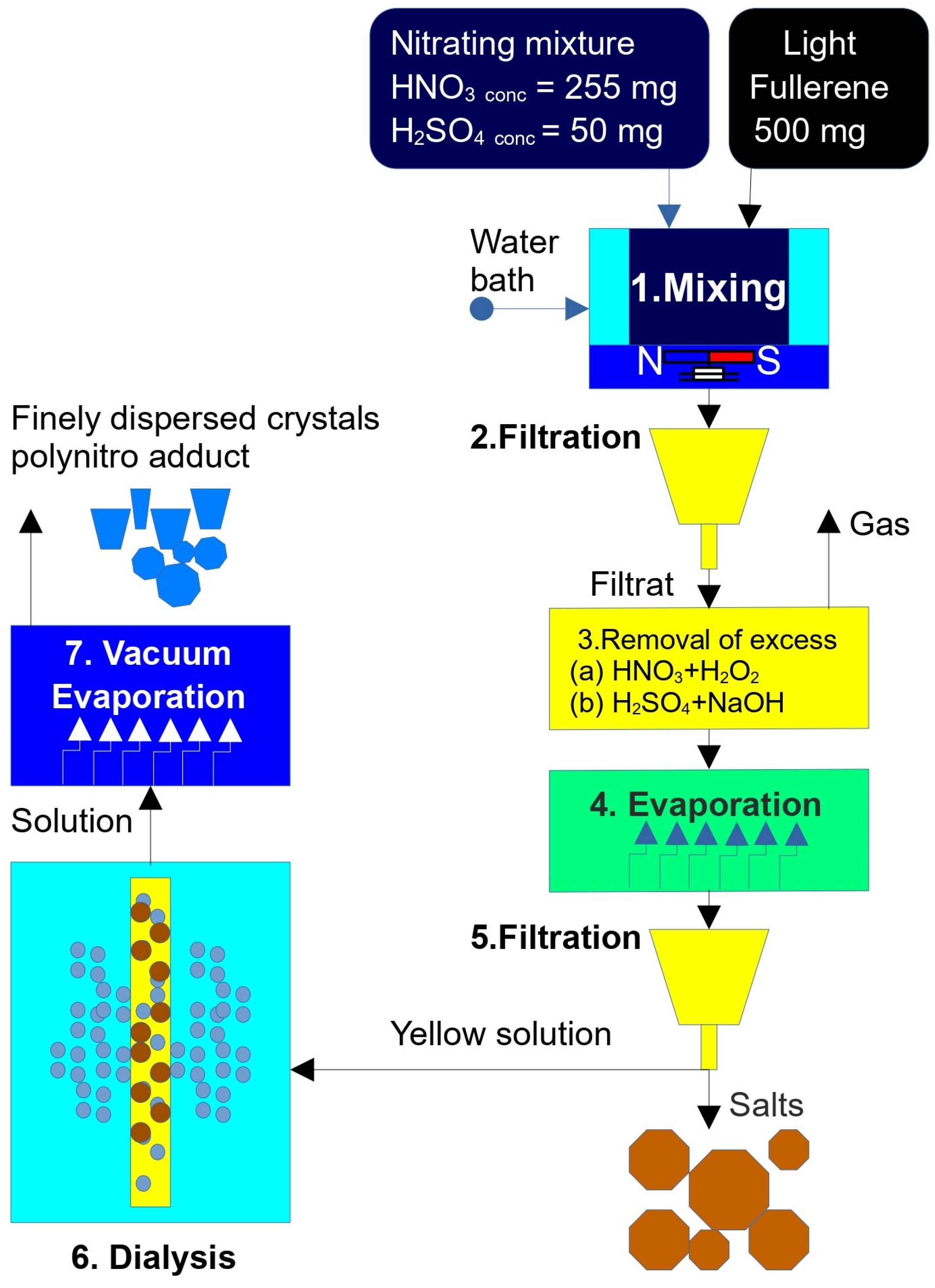

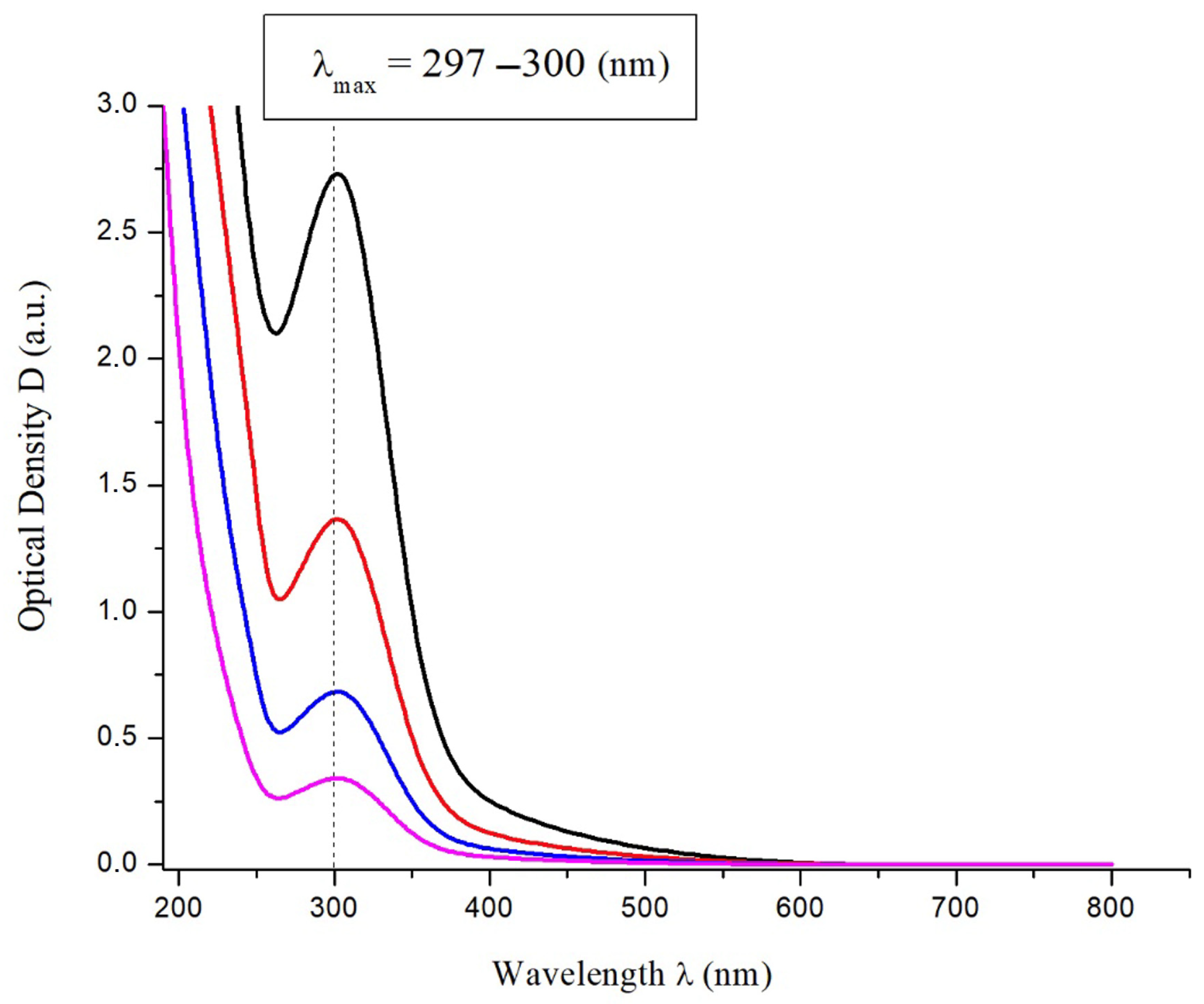
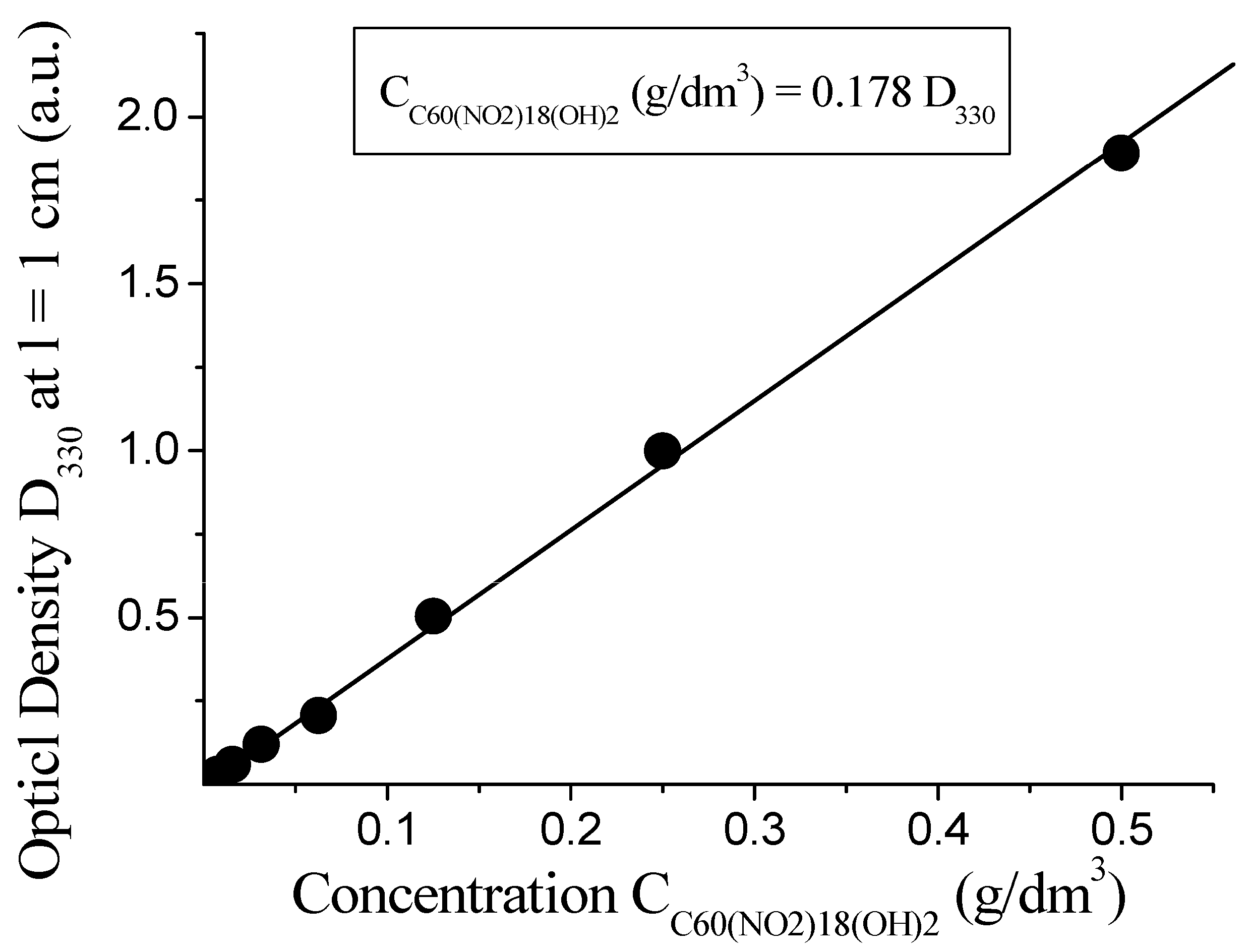
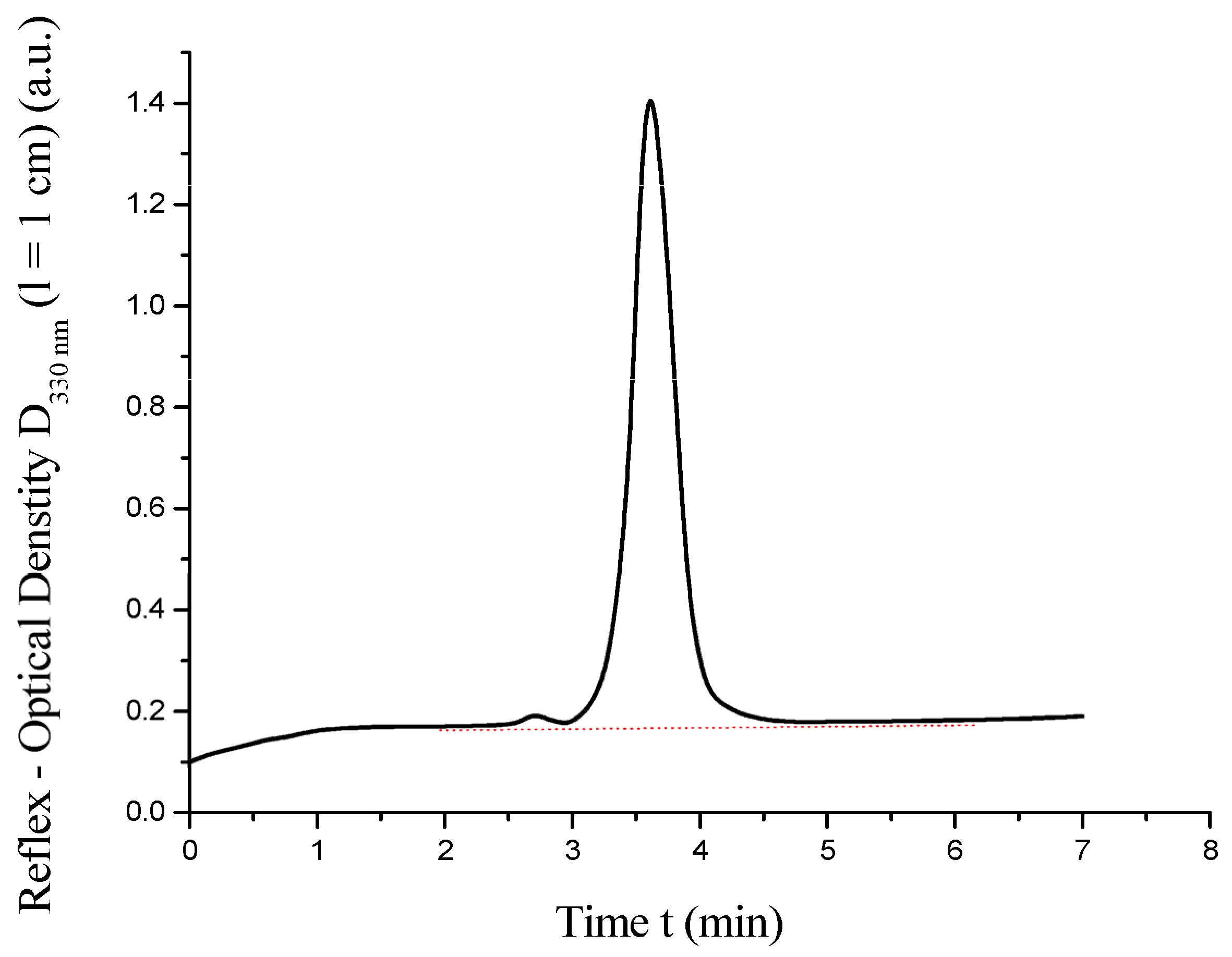
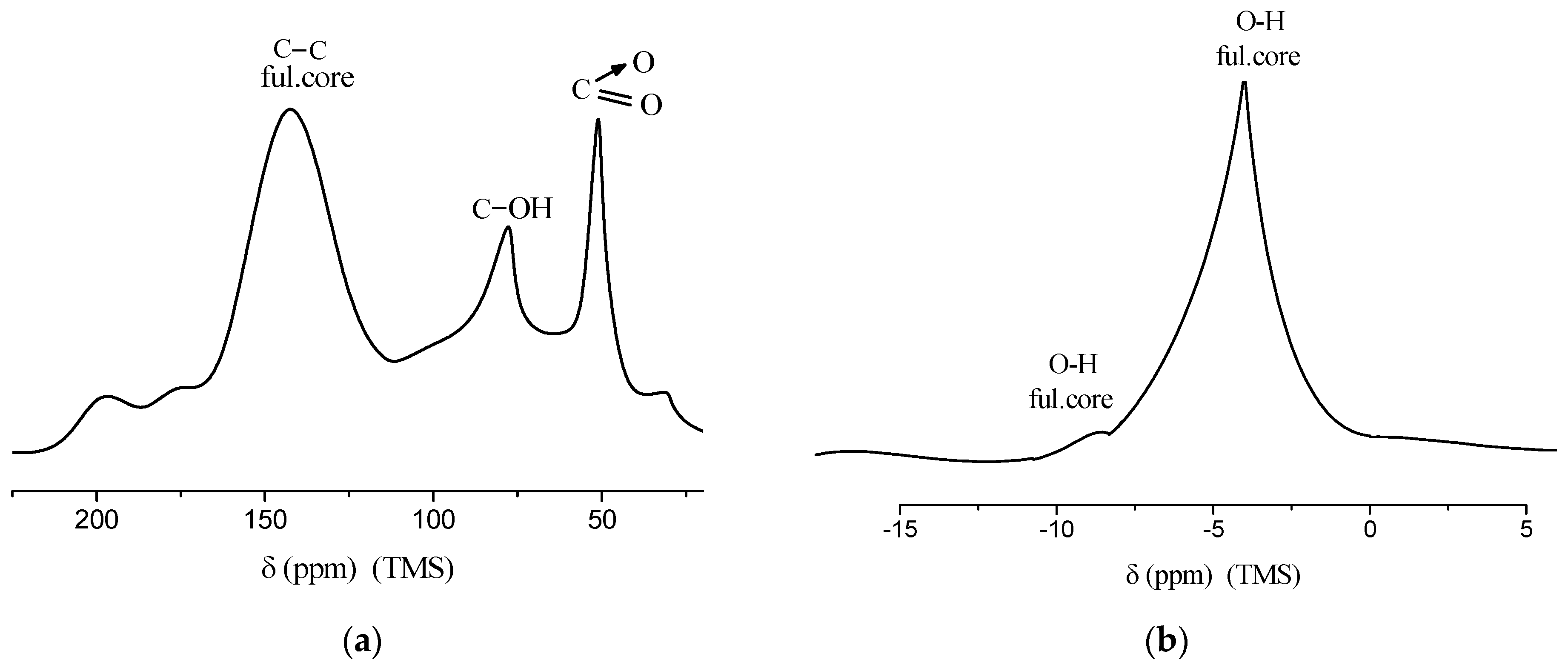
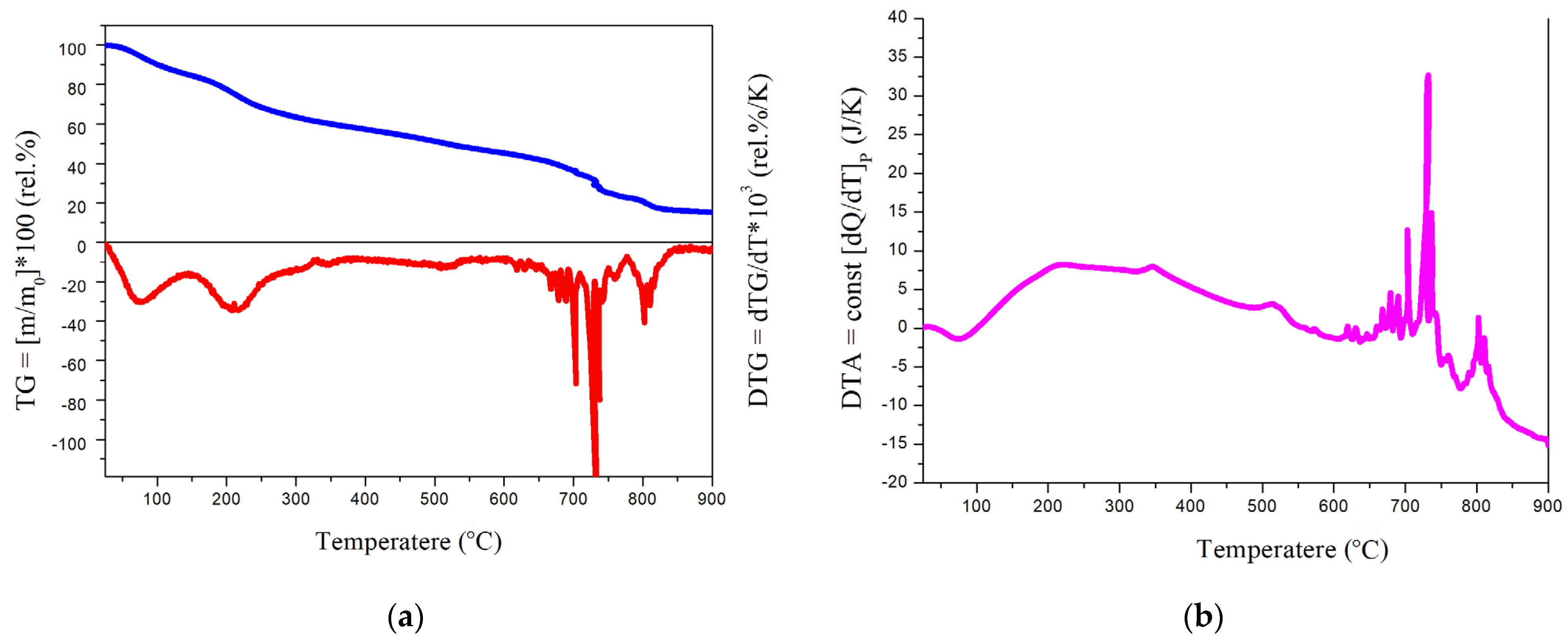
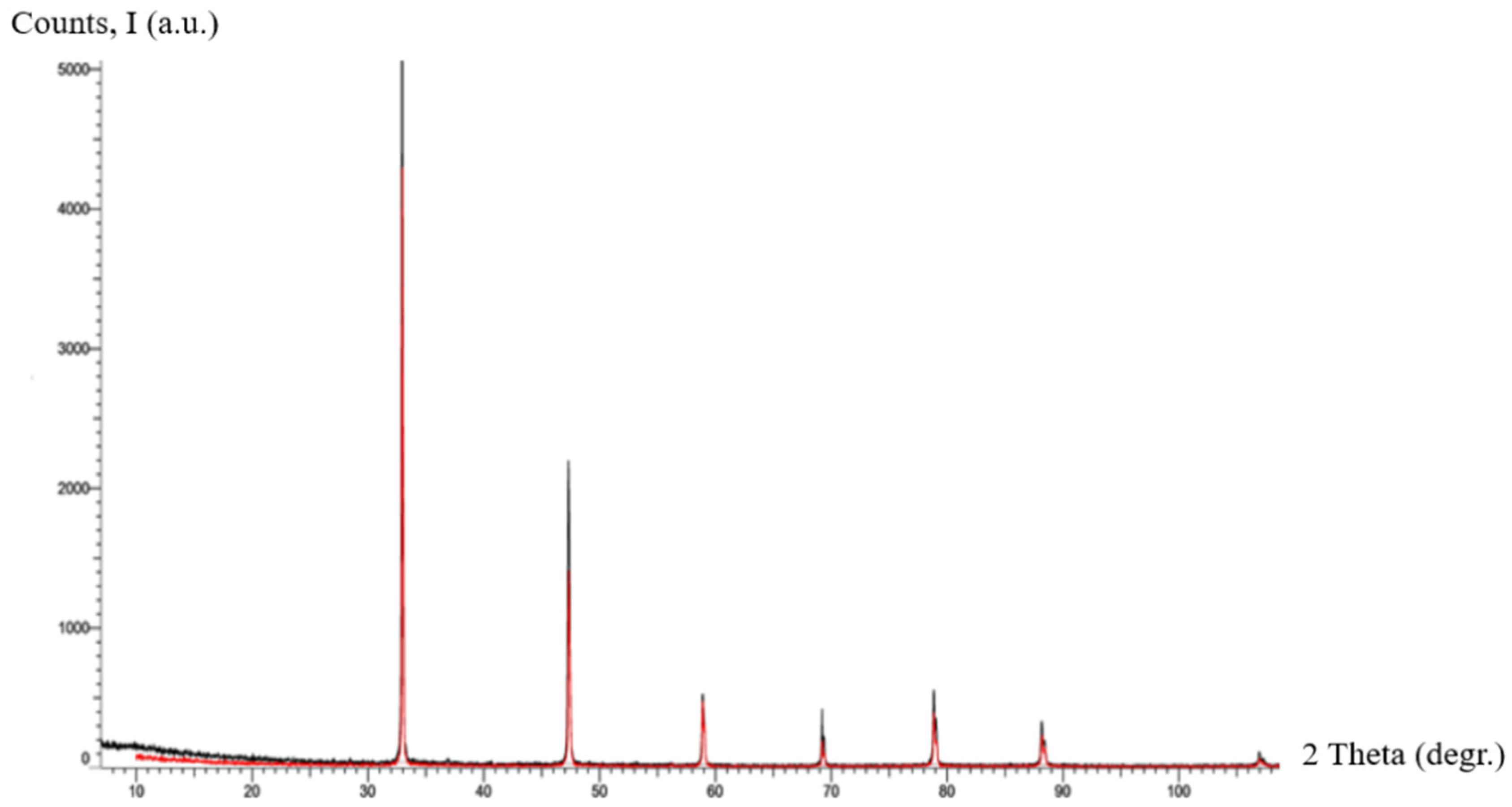

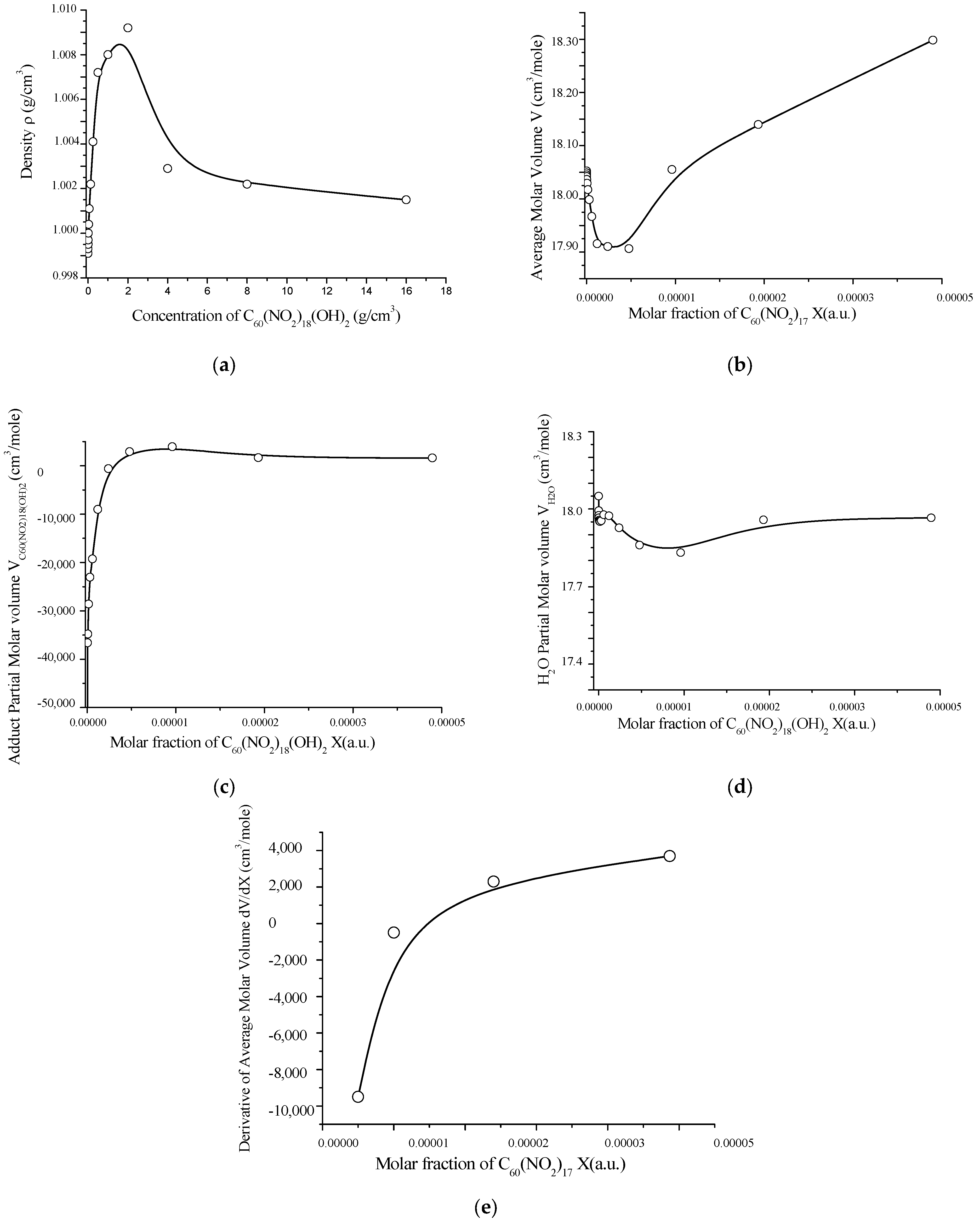
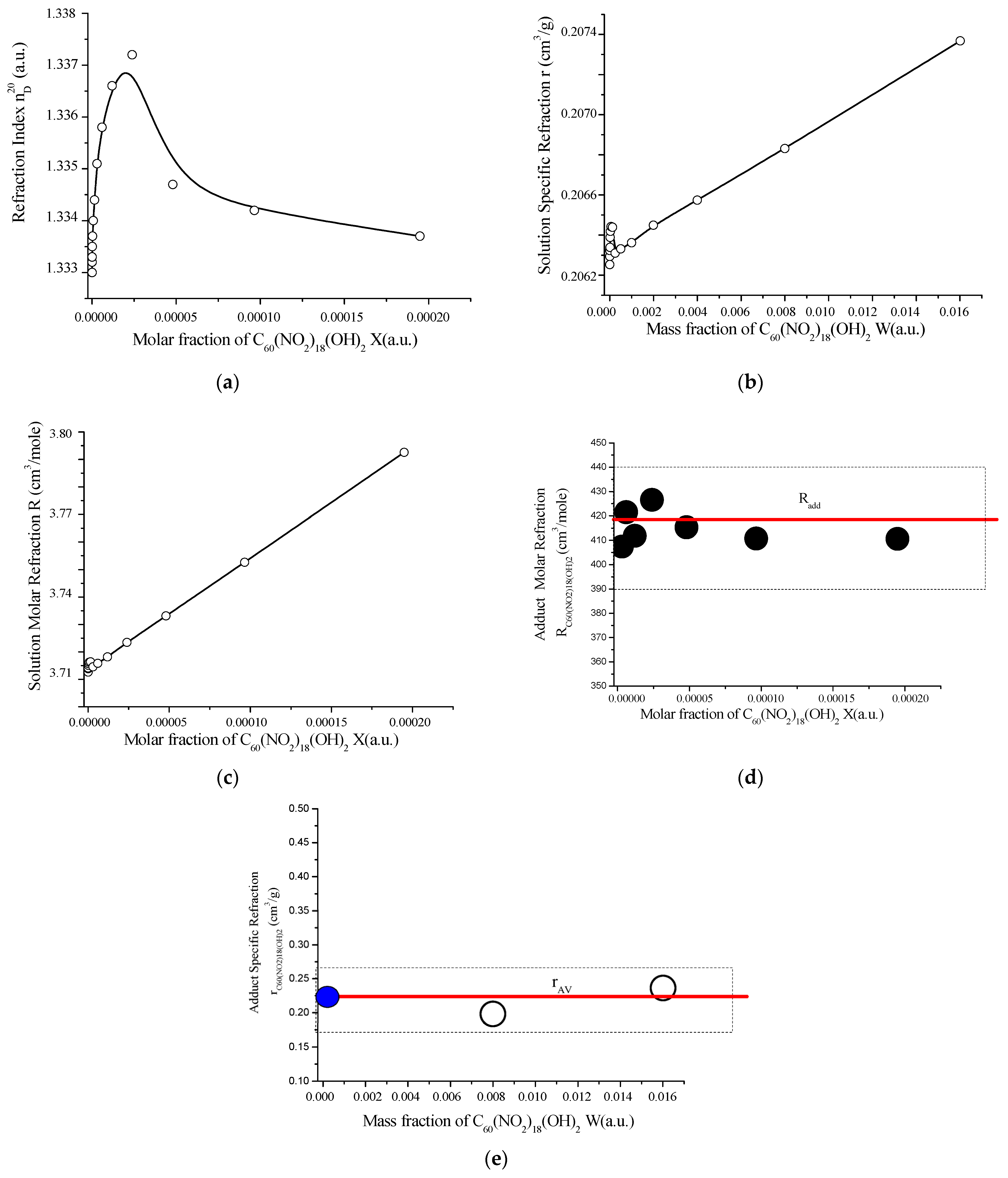
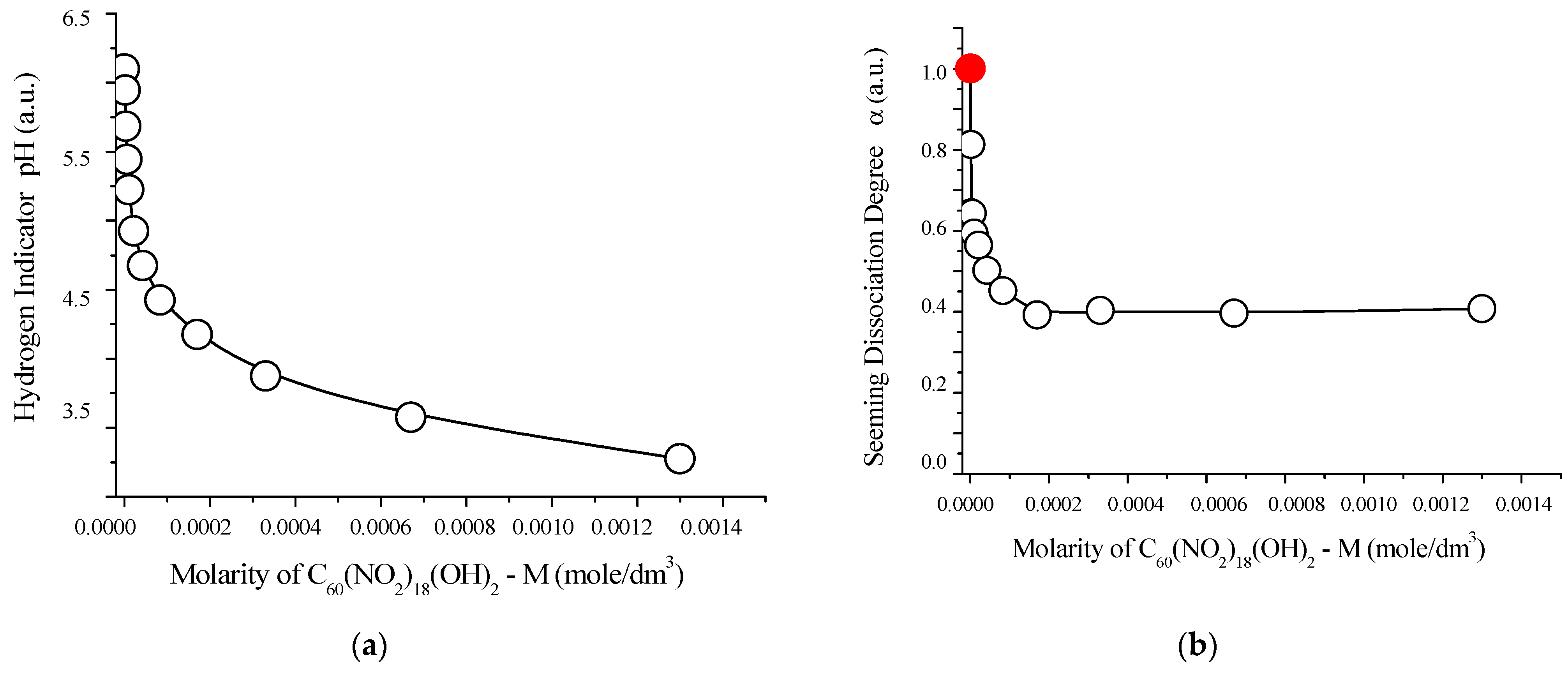

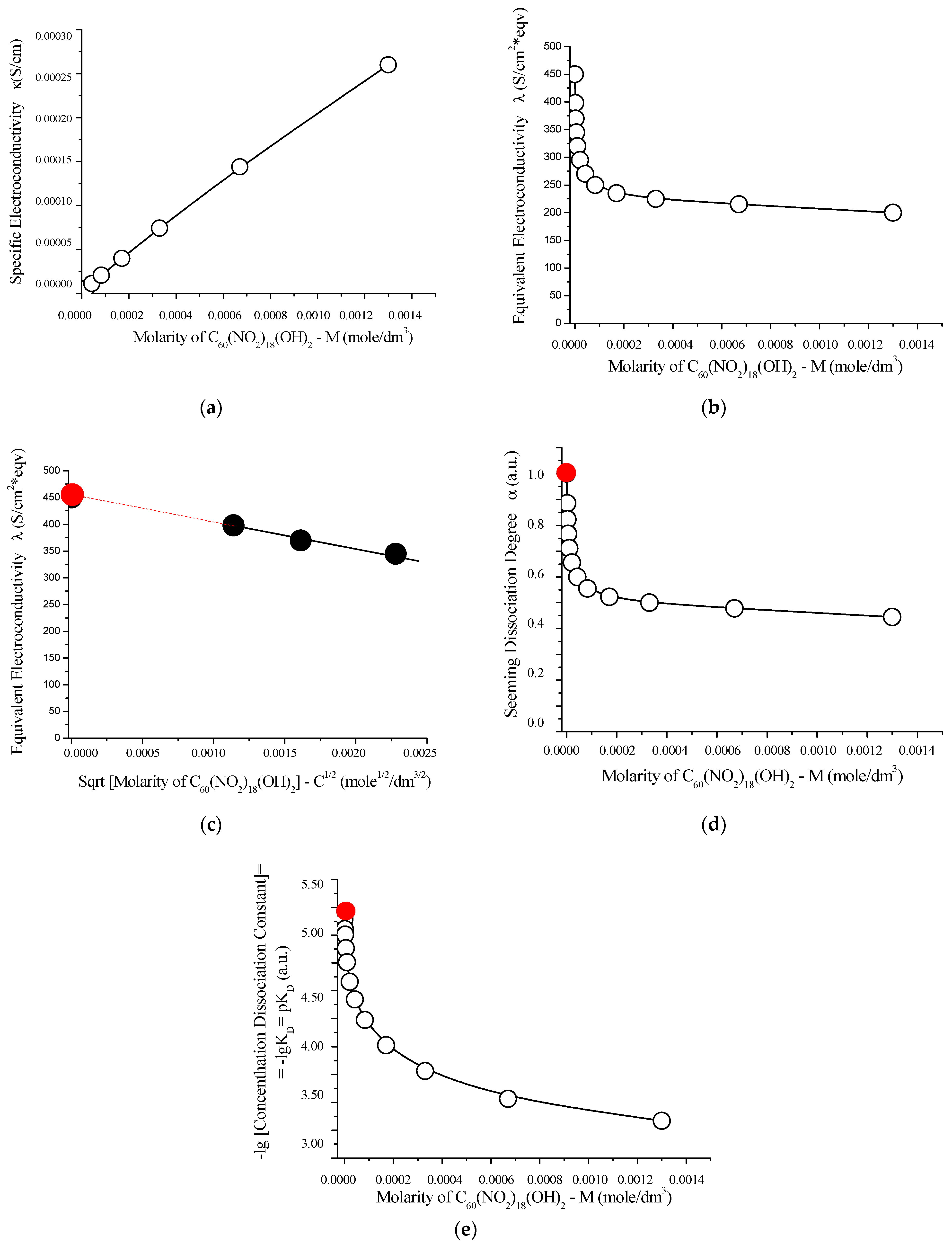
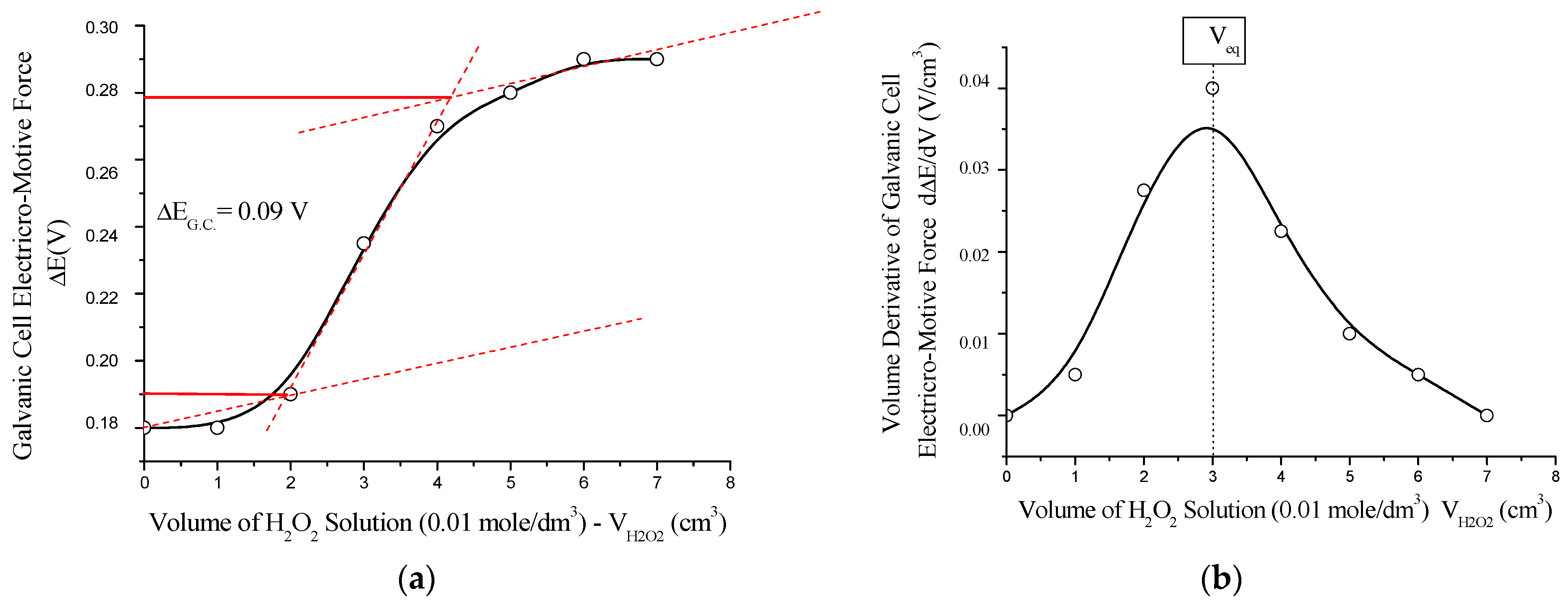
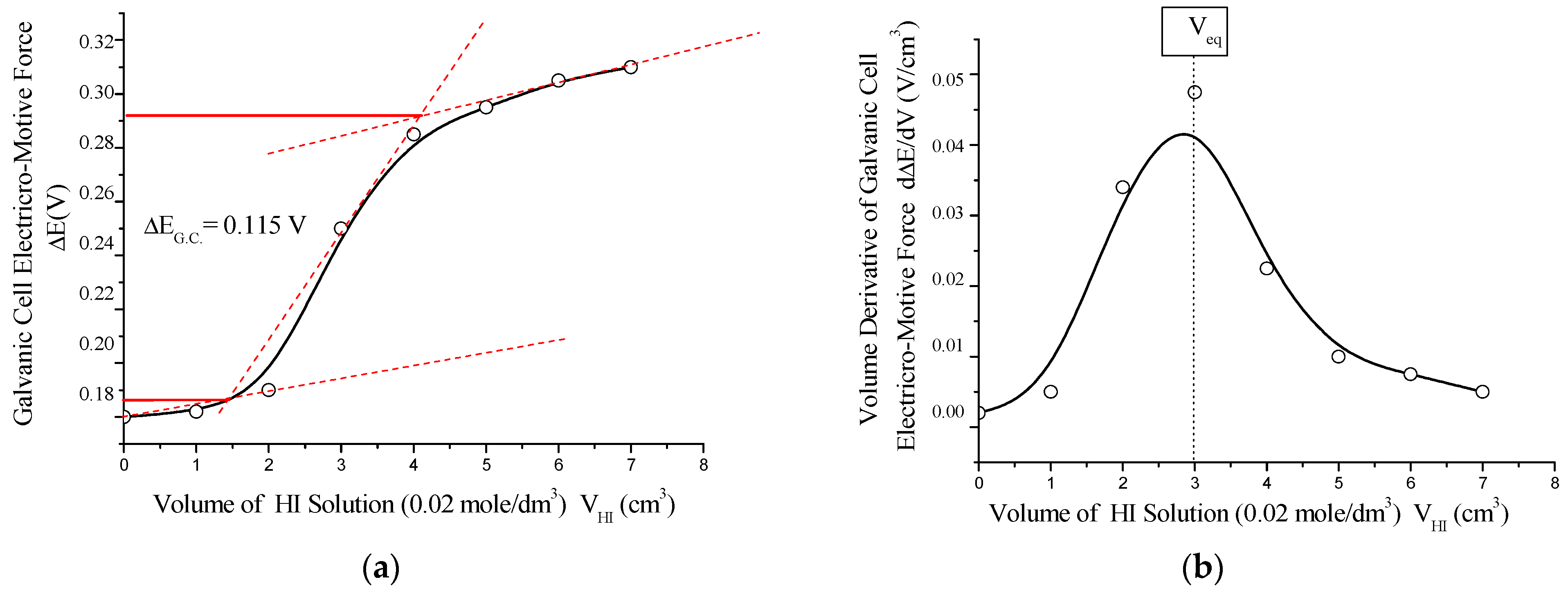
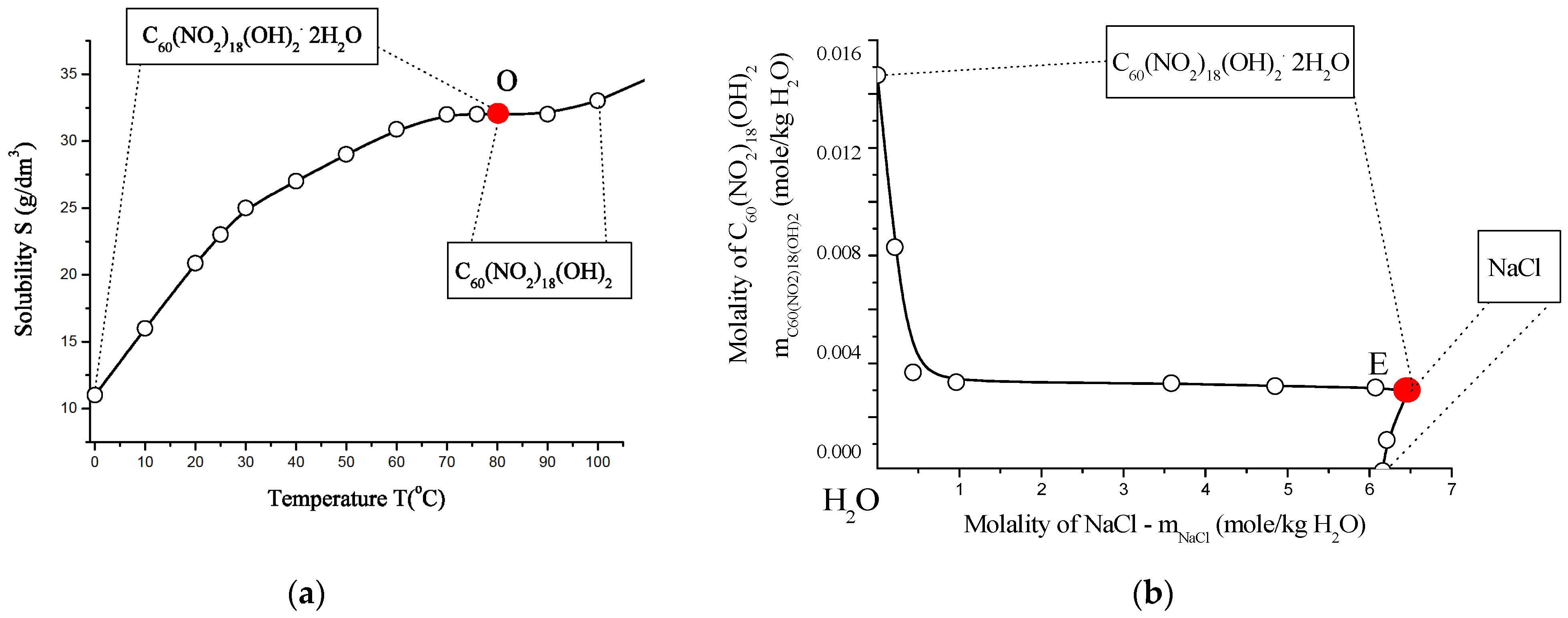

| Element | Theoretical Amount Ctheor, %, wt | Experimental Amount— Cexp, %, wt |
|---|---|---|
| C | 45.51 | 45.51 ± 0.1 |
| H | 0.13 | 0.13 ± 0.1 |
| N | 16.0 | 16.0 ± 0.1 |
| O | 38.43 | 38.43 ± 0.1 |
In Water Solution (a.u.) | Liquidus Temperature Decrease ∆T (K) (a.u.) | lnaW ln (Water Activity) (a.u.) | lnγW ln (Water Activity Coefficient) (a.u.) | ln (poly-Nitro-Adduct Activity Coefficient) (a.u.) |
|---|---|---|---|---|
| 0.000 | 0.000 | 0.00000 | 0.00000 | 0.000 |
| 2.84 × 10−6 | 0.065 | −0.00063 | −0.00063 | 24.8 |
| 5.69 × 10−6 | 0.11 | −0.00106 | −0.00106 | 48.1 |
| 1.13 × 10−5 | 0.19 | −0.00184 | −0.00183 | 90.9 |
| 2.27 × 10−5 | 0.27 | −0.00262 | −0.00259 | 161 |
| 4.55 × 10−5 | 0.41 | −0.00398 | −0.00393 | 248 |
| 9.10 × 10−5 | 0.64 | −0.00622 | −0.00613 | 278 |
| 1.82 × 10−4 | 0.91 | −0.00886 | −0.00868 | 281 |
| VD-AS Parameters | Diffusional Instability Concentration Region | ||||
|---|---|---|---|---|---|
| Λ2 (a.u.) | Λ3 (a.u.) | Λ4 (a.u.) | (a.u.) | Xdiff-instab-start (a.u.) | Xdiff-instab-finish (a.u.) |
| 4.48 × 106 | −2.96 × 1010 | 6.60 × 1013 | 0.93 | 7.9 × 10−5 | 1.4 × 10−4 |
| No | Research Method | Device |
|---|---|---|
| 1 | Elemental analysis | C/H/N analyzer 5E-CHN2200 and electronic microscope VEGA-3 TESCAN (XRF analyzer, Brno, Czech Republic) |
| 2 | Infrared spectroscopy | Spectrophotometer Shimadzu FTIR-8400S ( = |
| 3 | Electronic spectroscopy | UV-VIS-NIR Shimadzu, Kyoto, Japan; λ = 200–1110 nm; standard—H2O (distilled) |
| 4 | High-performance liquid chromatography | HPLC Agilent 1200, San Clara, CA, USA; Column-Agilent Zorbax SB-C18; Eluent: ; Detection-spectra-photometry at |
| 5 | Nuclear magnetic resonance | 13C; 1H; AVANCE-II 400WB Bruker, Berlin, Germany; TMC; 100.4 MHz. |
| 6 | Complex thermal analysis | Shanghi Jiahang Instruments Co., Ltd., Shanghai, China; Device JHDTA332; Atmosphere—air, pressure—1 atm., temperature range T = 25 ÷ 950o C, rate: 5 °C/min. |
| 7 | X-ray diffraction | Powder diffractometer (Bruker, Berlin, Germany). The anode material of the X-ray tube is cobalt ( λ = 1.78897 Å); the exposure time at the point is 0.2 s; the angular range is 2θ—10–80 °; the accelerating voltage is Uacc. = 30 kV; and the current of the anode circuit is I = 10 mA. Sample preparation: 1. The poly-nitroadduct was placed in an agate mortar and crushed by grinding for 10 s to a medium dispersed state. 2. By adding ethanol, a suspension was obtained. 3. The resulting suspension was applied with a brush to a mono-crystalline Si substrate (standard cuvette from the D2 Phaser kit) 4. The suspension was dried in a cuvette using infrared radiation from a halogen lamp at a temperature . |
| No | Research Method | Device |
|---|---|---|
| 1 | Dynamic light scattering—DLS | Malvern Zetasizer Nano ZS90 |
| 2 | Density | Quartz pycno-meters |
| 3 | Refraction-metry | Refraction-meter HRK 9000 A |
| 4 | Electric properties | Immitance RLC-meter—HAMEGHM8118 |
| 5 | Acid-base properties | Seven Compact pH meter S220, |
| 6 | Potentiometric titration | Ion meter-voltmeter 781 pH/Ion Meter. |
Disclaimer/Publisher’s Note: The statements, opinions and data contained in all publications are solely those of the individual author(s) and contributor(s) and not of MDPI and/or the editor(s). MDPI and/or the editor(s) disclaim responsibility for any injury to people or property resulting from any ideas, methods, instructions or products referred to in the content. |
© 2025 by the authors. Licensee MDPI, Basel, Switzerland. This article is an open access article distributed under the terms and conditions of the Creative Commons Attribution (CC BY) license (https://creativecommons.org/licenses/by/4.0/).
Share and Cite
Kulenova, N.; Sadenova, M.; Azamatov, B.; Maratuly, B.; Charykov, N.; Arshinov, M.; Beisekenov, N. Synthesis and Characterization of a Water-Soluble Nanomaterial via Deep Nitration of Light Fullerene C60. Inorganics 2025, 13, 212. https://doi.org/10.3390/inorganics13070212
Kulenova N, Sadenova M, Azamatov B, Maratuly B, Charykov N, Arshinov M, Beisekenov N. Synthesis and Characterization of a Water-Soluble Nanomaterial via Deep Nitration of Light Fullerene C60. Inorganics. 2025; 13(7):212. https://doi.org/10.3390/inorganics13070212
Chicago/Turabian StyleKulenova, Natalya, Marzhan Sadenova, Bagdat Azamatov, Bauyrzhan Maratuly, Nikolay Charykov, Mikhail Arshinov, and Nail Beisekenov. 2025. "Synthesis and Characterization of a Water-Soluble Nanomaterial via Deep Nitration of Light Fullerene C60" Inorganics 13, no. 7: 212. https://doi.org/10.3390/inorganics13070212
APA StyleKulenova, N., Sadenova, M., Azamatov, B., Maratuly, B., Charykov, N., Arshinov, M., & Beisekenov, N. (2025). Synthesis and Characterization of a Water-Soluble Nanomaterial via Deep Nitration of Light Fullerene C60. Inorganics, 13(7), 212. https://doi.org/10.3390/inorganics13070212










